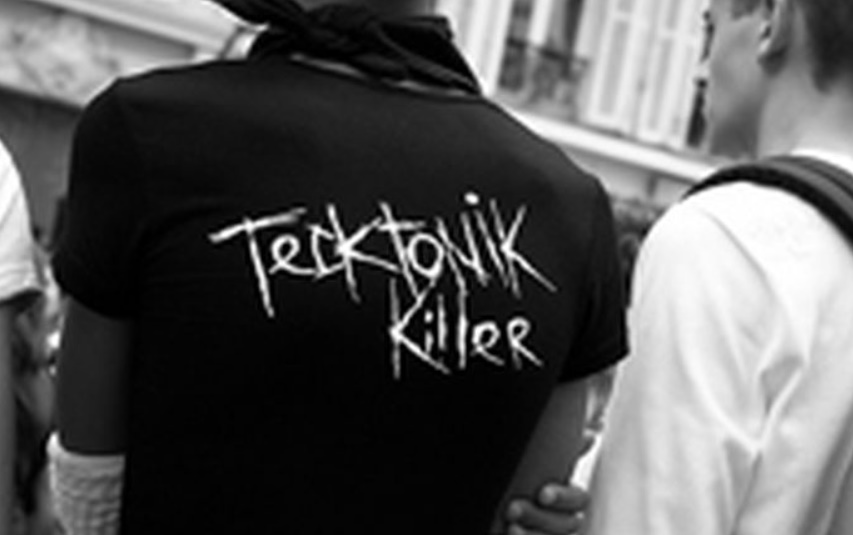Do you remember the early 2000s era with spiky mullet hairstyles, tight pants, and neon-colored gloves? It’s the Tecktonik reign I’m talking about.
It was one of the most popular trends in France back then, on the same level as breakdancing and krumping on the other side of the ocean.
How did it start?
Table of Contents
Tecktonik Dance Origin & History
Born to be a phenomenon
In 2002, a project named “Tektonik Events” started in France in the form of “Tecktonik Killer” parties, organized by Cyril Blanc and Alexandre Barouzdin.
Their primary goal was to promote the hardstyle and jumpstyle of music from Belgium and Holland to France.
DJs who played in the hardstyle at the Metropolis Club would usually go for one of the three types: Blackout, Electro Rocker, and Tecktonik Killer. According to Cyril, Tecktonik is a pun inspired by the tectonic plates.
As Tecktonik parties became a phenomenon, the duo recruited designers and staff members to create merchandise such as tight clothes and mittens with neon colors.
The “Tecktonik Killer” evenings were such a huge success that their creators could turn “TCK” and “Tecktonic” into trademarks, so other clubs would be prohibited from using these terms.
More products like energy drinks and exclusive clothing were also released.
The influence of Tecktonik spread beyond France’s territory and traveled to Tunisia thanks to videos posted online and street gatherings.
It was only a matter of time before the mainstream platforms paid attention and consequently increased their popularity.
Since 2007, the frequency of Tecktonik’s appearance in mainstream videos only went up with “Alive” (Mondotek), “A cause des Garçons” (Yelle), or various songs by Lorie and similar artists. The Techno Parade occurring in the same year also contributed to its visibility.
Tecktonik became a brand under TF1, a TV network specialized in commercials with the largest share in its field. Therefore, clubs are forbidden from using “TCK” and “Tecktonik” in their projects unless permitted by Cyril and Alexandre.
The fire is extinguished
When something becomes a trend, it is mostly because of the course of events and the social context supporting it. These factors are bound to change with time, hence trends inevitably die down.
In Tecktonik’s case, its roots were in subculture and belonged to the underground. So, whether people liked it or ridiculed it, they were curious. Too much mainstream exposure somehow ruined the sense of exclusivity and mystery.
As people saw a plethora of Tecktonik content and products, the hype for it gradually waned, and it soon became but a shadow of its glory.
Check more: Where Did The Floss Dance Come From? How To Do It?
Tecktonik Dance Moves
The most basic description of the Tecktonik dance style would be predominant arm movements and limited use of the legs.
Professionals believe Tecktonik was inspired by various glowsticking elements, namely Figure 8, the Leading Hand concept, or the Freehand idea.
All of these complex hand movements are executed with a touch of disco, hence the dancers are required to pose and point.
In synchronization with the hands, the dancers will need to shuffle around the dance floor using their hips and knees to assist their steps. Although they can be spontaneous and jerky with the footwork, remaining in touch with the beat is a must.
More advanced dancers might include b-boy, top rock, and hip-hop elements in their routines. All of these styles combine with electro-house music quite well.
A Dynamic Fusion Of Various Electro-Styles
As you can see, it is impossible to describe Tecktonik dance steps with only a few keywords. Many electro-ish dance styles have been combined to create Tecktonik, with Milkyway and Vertigo being the most prominent.
Furthermore, you can pinpoint a characteristic fusion of powerful, sometimes violent, movements to match electro and tech-house music. This is why people consider Tecktonik a unique and electrifying experience in every sense of their bodies.
In Tecktonik, you can find the diversity usually present in hip-hop, for example, the coexistence of locking and popping. The voguing aesthetics it carries also plays an important role both in the clubbing gatherings and the dance battles.
You will find a professional Tecktonik dancer to be extremely agile and precise with synchronized and rapid moves with their hands, and their legs simultaneously changing directions (which might be a reminder of voguing).
This explains why Tecktonik is also acknowledged as a quality exercise for better athleticism.
Attires For Tecktonick Dance
Influenced by hip-hop and generally the underground culture, attitude is crucial in Tecktonik. Most of the time, you will see the dancers expressing carefree smiles and borderline nonchalance.
To match this spirit, the fashion for Tecktonik must also be impressive.
Back in the day, one could tell a Tecktonik dancer from other styles based on the mullet hair, tight clothes (emphasized on sleeveless tops), and bright colors.
Tecktonik Dance Nowadays
Murielle Lellouch, the manager of the Parisian shop and the friend of the founder duo, once shared about how the grand market affected the essence of Tecktonik negatively.
It was true, the parties and gatherings focusing on Tecktonik eventually disappeared. Dance battles between young groups also became more and more scarce and the movement faded into the past.
Nonetheless, Tecktonik isn’t completely gone from French culture. People who lived through the early 2000s couldn’t seem to forget about the innovative dance that took the country by storm.
After the feast, the French folks will be more than happy to show you this iconic dance.
Final Words
From a movement to promote new music and create a bond among young individuals, the Tecktonik dance went from a subcultural trend to a mainstream phenomenon before its inevitable deterioration.
However, loyal French elders stayed with it until today, proving its special place in France’s cultural history and the people’s memory.
